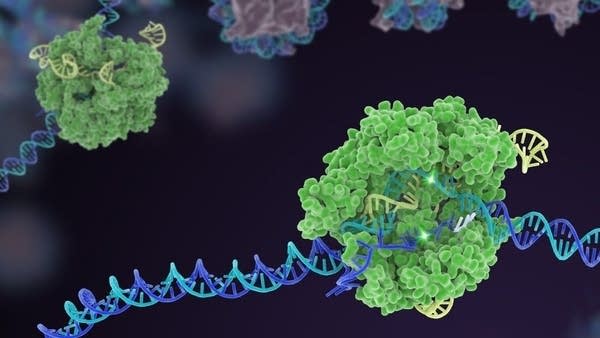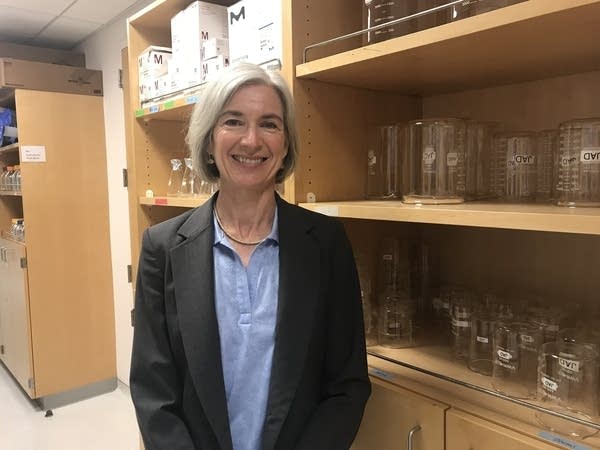The Nobel laureate says using gene-editing technology to modify human microbiomes, potentially with the help of artificial intelligence, could eliminate some chronic diseases.

The technology known as CRISPR is considered one of modern biology’s biggest breakthroughs. It allows scientists to edit genes, similarly to how you cut and paste text in a word processor.
More than a decade after pioneering CRISPR, Nobel laureate Jennifer Doudna of the University of California, Berkeley, is applying it to big problems, like chronic disease and climate change.
Marketplace’s Lily Jamali recently met up with Doudna at Berkeley’s Innovative Genomics Institute. It’s a cluster of lab stations, researchers and very loud refrigerators where CRISPR is being used to edit human microbiomes. Doudna discussed the potential of modifying the genetic material in these vast collections of bacteria, viruses and other microorganisms that live on and in our bodies.
The following is an edited transcript of their conversation.
Jennifer Doudna: It’s not easy to manipulate microbiomes. Even though we know that CRISPR came from these organisms, it turns out that introducing CRISPR back into those bugs is nontrivial, especially because we want to manipulate all of those bugs at different times.
Lily Jamali: Nontrivial, meaning it’s hard to do?
Doudna: It’s hard to do. There are both technological issues but also fundamental science to be done to understand which genes need manipulating and then how to do that.
Jamali: And you’re working on applying this to, among other things, childhood asthma. Is the hope to cure or to alleviate the condition?
Doudna: I imagine a day when we can prevent asthma. Imagine that we could manipulate the microbiome to eliminate disease-causing molecules that the microbiome emits that give some people susceptibility to asthma. This would be an extraordinary advance.
Jamali: What’s the timeline for that kind of project?
Doudna: It’s always hard to put a timeline on projects of that nature because by definition, they are high-risk, but very high-payoff. Our aim at the moment is to make real progress clinically within seven years. We have funding over that period of time.

Jamali: One of the things I am very interested in with CRISPR, and with biotech in general, is affordability and accessibility. Is that something that’s on your mind?
Doudna: I think that the question of affordability and accessibility is top of mind with genome editing because we can already see that the technology is moving quickly. The opportunities are very exciting. We’re on the verge of the first approval of a CRISPR therapy for sickle cell disease, probably before the end of the year. And yet, there’s still a relatively small number of people that have been treated with CRISPR. And how do we expand those numbers? It’s going to require making the technology much more affordable and accessible.
Jamali: So, in tech-speak, is this the moment that you scale? Is that what’s happening right now?
Doudna: Definitely. We’re absolutely interested in scaling up. We’re expanding our efforts. We’re hiring people and inviting students and everybody up to senior faculty and companies to partner with us and join the effort and the vision that we have to expand the impact of CRISPR.
Jamali: Was this the type of application that you had in mind when you first started working on CRISPR 16 years ago?
Doudna: Certainly not. But this is what’s happening with CRISPR because it’s a cross-cutting technology that allows manipulation of DNA in any type of organism. The more we think about it and advance the technology, the more we recognize opportunities that weren’t obvious in the beginning.
Jamali: So, what are some of the things that researchers are working on in your lab?
Doudna: In this lab, we’re working on fundamental aspects of the CRISPR system that will ultimately let us target it to microbiomes and, of course, other systems as well. It’s really exciting to put CRISPR, which is a wonderful technology, together with another exciting breakthrough called metagenomics, which means being able to analyze whole groups of organisms in one shot. This is what Jill Banfield‘s lab does. They are some of the world’s experts in this area, making it possible to identify organisms at the level of their DNA. So, we don’t even have to isolate those organisms, we can actually study them in their native populations.
Jamali: The last time that we got to speak, it was three years ago at the height of the COVID-19 pandemic, and we talked about this pretty extraordinary effort that you had decided to undertake in terms of developing a new COVID test that was saliva-based. Three years later, you know, how did that go? And what are some of the things that you learned from that experience?
Doudna: During the COVID pandemic, the Innovative Genomics Institute started a testing lab to provide clinical-grade testing for people across the whole campus of UC Berkeley, but also around the Berkeley and Northern California community. We decided to focus on a saliva-based test because it would be fast, inexpensive and potentially very quick to implement in communities that didn’t have a lot of resources and infrastructure. That worked out really well. We ended up providing over 600,000 tests around this area of Northern California, and we were also able to build teams of people who worked on innovating in real time. I think it taught us some important things about teamwork that we’re hoping to expand now into other areas where we’re working.
Jamali: Like what? How is that important to what you’re doing now?
Doudna: I think what academic organizations do well is attract very smart people who want to work on big problems. But often, what they don’t do well is build teams of people that are all rowing in the same direction. That’s really what the IGI does. It creates a vision and then invites people to come together to work with us to participate in a team effort. And it’s been highly effective not only during COVID, but also now in this era where we’re expanding the opportunities with CRISPR.
Jamali: It makes sense that it would need to be very collaborative, but it sounds like what you’re saying is sort of against the culture of a lot of scientific institutions.
Doudna: I think a lot of academic groups, and I know this is true for me, are trained to be individuals. That’s sort of prized in academics, to be this kind of a person who is innovating on your own. However, there are times when you really need to build teams of experts who have complementary skill sets that they can bring to the table. And that’s really what we’re doing at IGI, is building those kinds of teams. It’s very exciting.
Jamali: I wonder, is AI part of this at all?
Doudna: Absolutely. We’re very excited about the opportunities to merge the advances happening so quickly in machine learning and artificial intelligence with things that we’re doing in our experimental lab. And you might ask, how do you bring those things together? One thing to appreciate is that CRISPR generates enormous amounts of genetic data about the function of genes, and up until now it’s been hard to mine those data sets. It’s very difficult to manually find signals in the data. We think that with machine learning — artfully applied, of course — we have to think hard about how we’re going to do it, but we’re going to be able to find a lot of insight into the function of genes in the human genome, but also in many other organisms, including microbes that will impact the work that we’re doing here.
In 2018, a Chinese scientist named He Jiankui announced he’d created the first gene-edited babies, twin girls named Lulu and Nana. The news caused an uproar in the scientific community over the ethics of his experimentation. Ethical dilemmas posed by CRISPR continue to be widely debated five years later, with scientists working to ensure safer and more precise ways of using the technology.
Jennifer Doudna took to the TED stage in April. In her talk, she laid out the next big advances in CRISPR, including using it to target emissions of methane, a potent greenhouse gas. A chunk of those emissions come from a surprising source — cow burps! The plan? Modify the microbiomes of cows when they’re born, and they’ll burp out less methane over the course of their lives.
In the meantime, the Food and Drug Administration is weighing a treatment for sickle cell disease using CRISPR. That decision will be an early test case for how the FDA views products developed with gene-editing technology.